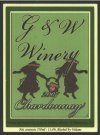 Last year, WineMaker held its annual label-making contest for home winemakers. Some of the submissions were comical, some were incredibly artistic, and some left the judges’ glasses half-empty. In the end, few survived the demanding critiques, and many perfectly fine labels had to go without recognition. One label, however, simply had to sit in a state of purgatory (for a few short months) before reemerging on my desk. Although it was passed over in the competition, the story makes it a true work of art.
Last year, WineMaker held its annual label-making contest for home winemakers. Some of the submissions were comical, some were incredibly artistic, and some left the judges’ glasses half-empty. In the end, few survived the demanding critiques, and many perfectly fine labels had to go without recognition. One label, however, simply had to sit in a state of purgatory (for a few short months) before reemerging on my desk. Although it was passed over in the competition, the story makes it a true work of art.
Dennis Hasson submitted two labels for Merlot and Chardonnay that he produces out of a small vineyard in Pine Barrens, a forested coastal plain in Southern New Jersey. His winery was inspired by the birth of his twin daughters, Grace and Willow. Fittingly, the winery was named after the two girls and thus the beginning of G & W Winery in Williamstown, New Jersey.
The label submitted for G & W Winery displays a picture of two silhouetted girls carrying a basket of grapes. They are skipping along, seemingly happy in their gypsy garb. In his submission, Hasson wrote about the inspiration for this particular label. His explanation began, “Boy this is almost impossible for me to put into words!!”
Naturally, I read on.
When Hasson’s wife, Marie, was three months pregnant with identical twins, she was diagnosed with a disease known as “Twin to Twin Transfusion Syndrome” (TTTS). According to an article in the Health and Science section of the Philadelphia Inquirer, this disease afflicts 10 to 15 percent of all identical twins that are born in any given year. The complications are many, and often debilitating.
Like all identical twins, the two fetuses shared a placenta. However, due to the disease, the two developed irregularly. According to that same article, the twins were connected by a dysfunctional blood vessel that caused one twin to receive a disproportionate amount of blood. Basically, one twin was receiving too much blood while the other was losing too much. The results of this kind of disease can include a variety of major birth defects, including miscarriage or death from a premature birth.
The odds were not in the Hasson’s favor. They were told that there was only a 30% chance of survival, and a 70% chance of major birth defects. After careful deliberation, they decided that Marie would undergo experimental surgery in an effort to save their unborn children. After the surgery, and four months of bed rest, Marie gave birth to two very tiny (2.5 and 3.5 lbs.), yet healthy, twin girls at the Children’s Hospital of Philadelphia. According to Hasson, this was the first such case in the hospital’s history in which both children were born healthy and
without defects.
Wanting to share their happiness and newfound appreciation for life with others, the Hassons turned to wine. When Grace and Willow were still very young, the couple spent a few years researching wine and winemaking techniques. Their research included readings, tastings, and a few wine schools, as well as (they say) a tip or two from a certain, home winemaking publication.
Shortly thereafter, when the twins were around 4-years-old, grapes were growing on the Hasson’s land, which was a vineyard in years past. The southern New Jersey climate is well suited for a vineyard, and within a couple of years the wine was flowing. The Hassons are now entering their fourth year of wine production. They currently make Merlot, Chardonnay, Riesling and most recently, Cabernet Sauvignon. The source of their inspiration, Grace and Willow, can be found on every bottle.
The artist who designed the labels received a fitting description of the girls from friends of the Hasson family. They told the artist that the girls reminded them of “two forest nymphs.” Another close friend said of the girls, “They both just seem so happy to be alive.” From these words came the silhouetted illustration that can be found on each bottle leaving G & W Winery.
Mr. Hasson says Grace and Willow are currently active participants in the vineyard. The girls are often seen running up and down the rows in the vineyard and also did a majority of the foot stomping for last year’s harvest, one that yielded over 300 bottles of wine that have been the subject of “rave reviews.” The Hassons still remember the motivation behind their creation.
“The year the twins were born was absolutely the most difficult and wonderful year of our lives,” said Mr. Hasson, who said he hopes to someday be able to serve his wine at his daughters’ weddings. “It gave us a deep sense of gratitude and appreciation for life. We just wanted to share our joy with others as much as possible. Wine was a great choice.”
Steven McNulty is the Editorial Intern at WineMaker magazine. He is in his third year as a journalism major at Castleton State College in Castleton, Vermont.






